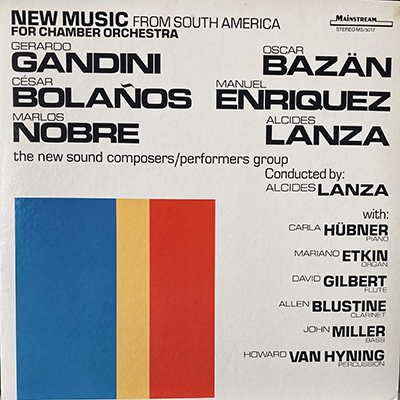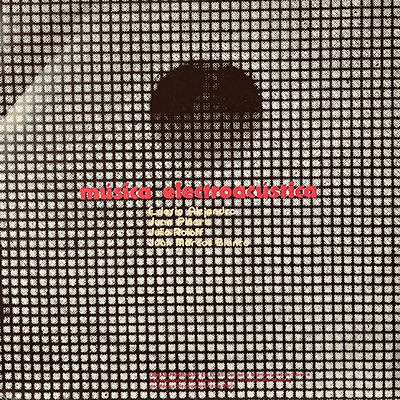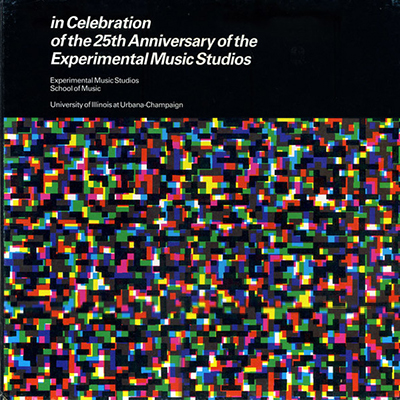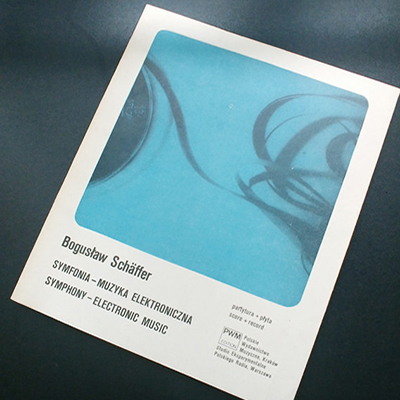Early ElectroMIX is a series to document the history of experimental Electronic music from the 50s to the 80s, composers making use of electronic instruments, test equipment, generators of synthetic signals and sounds, tape manipulations… to analog synthesizers…
While our sessions document those who make it today my desire is to transmit some pioneering works which paved the way to what we try to create.
Philippe Petit / October 2025.
Recorded for our series available on the platform
https://modular-station.com/modulisme/early-electromix/
Tracklist:
Nicole Lachartre – Ultimes (1978 / Metaphon) 00:00 > 18:05
Alcides Lanza – Penetrations II (1969 / Mainstream Records) 14:50 > 24:24
Juan Marcos Blanco – Ritual (1984 / Areito) 21:34 > 31:04
Herbert Brün – Sentences Now Open Wide (1984 / Private Press) 31:03 > 41:56
Bogusław Schäffer – Symphony (1973 / Polskie Nagrania Muza) 40:22 > 57:30
Bernard Parmegiani – Danse (1962 / VOX) 57:00 > 01:01:14

Nicole Lachartre – Ultimes (1978 / Metaphon)
Nicole Marie Lachartre was born in Paris in 1934. She immersed herself in playing the piano from an early age, entering the Conservatoire National Supérieur de Musique when she was eighteen. An internship with Pierre Schaeffer at the Groupe de Recherches Musicales de l’ortf (GRM) in 1967 led to a first artistic identity crisis: Lachartre seems to have been torn between the world of classical music and the radical avant-garde, with little opportunity for dialogue or mutual understanding between the two.
Then she worked in Pierre Henry’s Apsome studio, studied programming and the musical application of cybernetics.
She also became a committee member of the Société Internationale pour la Musique Contemporaine (simc) and worked as a research fellow at the grm from 1969 to 1972. In 1974 Lachartre founded the Association pour la Collaboration des Interprètes et des Compositeurs (ACIC), with herself as artistic director. Promoting sound experimentation and the recognition of electroacoustic music, while pursuing a continued interest in early music and traditional repertoire.
An electroacoustic composition produced at the Institute for Psychoacoustics and Electronic Music (IPEM) in Ghent. Recording of the première concert commissioned by Karel Goeyvaerts for the Belgian Radio and Television (BRT) on March 2nd, 1978.
An unsettling atmosphere pervades this work, in what sounds like a sonic katabasis – a journey to the underworld. The Ondes Martenot are played by the legendary Jeanne Loriod, who introduces the piece with a series of short messiaenesque melodic phrases. Waves of disincarnated vocal fragments soon start rolling in, like the wails of a gang of narcotized professional mourners. After some time the voices are joined by an insistent psychopompic horn and a buzzing organ chord. Tape manipulation is the key element at this point, exposing the liquid tendencies inherent to the medium itself, summoning what sounds like souls dissolving into the dark unknown. At the halfway mark, a chime reintroduces the Ondes Martenot in a peacock parade of colours, before eventually entering a bleak, inhospitable territory where they evidently lose their cool. Then, just as all traces of life seem to have died out, a final gasp by the virtuoso ondiste suggests a happy ending to the journey.

Alcides Lanza – Penetrations II (1969 / Mainstream Records)
Alcides Emigdio Lanza was a composer, conductor, pianist, and teacher born on June 2, 1929, in Rosario, Argentina.
From 1965 to 1971, at the Center for Electronic Music at Columbia and Princeton Universities, he worked with Vladimir Ussachevsky and also studied composition with Olivier Messiaen, Riccardo Malipiero, Aaron Copland, and Bruno Maderna, as well as piano with Yvonne Loriod.
In Latin America, as well as in the United States and Canada, Lanza worked to promote contemporary and avant-garde music, both as a pianist and conductor. He moved to Montreal in 1971 to teach composition at McGill University, while continuing his extensive international activities, and became director of the electronic music studio in 1974.
Earlier It was Bruno Maderna, however, who seems to have made the strongest impression on Lanza, perhaps because they shared so many interests and beliefs. Maderna played a great deal of electronic music in class, mainly from Europe, and stressed that, like any good composition, electronic works should have convincing musical phrases and a sense of structure. It was an ideal Lanza took to heart. In addition, Maderna was interested in the spatial distribution of sound and in mixed media. Lanza was delighted to discover that any possible sound was worthy of being used in a musical composition and his interest in sonic effects led him to investigate electroacoustic music.
In Columbia-Princeton, Ussachevsky opened the doors of the studio to composers of many different styles and backgrounds, including Varèse, Babbitt, Berio, Druckman, Dodge, Mimaroglu, to name only a few. Lanza also befriended Earle Brown and John Cage. Brown was the director of the Contemporary Sound Series of Time Records (later Mainstream Records) at the time he met lanza, and in 1969 he invited Lanza to make a recording of new music from South America for the series. Thus « Penetrations II » was his first work to be recorded in North America. It was also through Brown that Lanza met Lukas Foss, and through him that he met Morton Feldman. Lanza feels that he owes a great deal to this experimental group.
« These were the people who gave me positive feedback. They played my works and gave me many opportunities to perform in their concerts. As a composer and performer I was accepted without discussion. This acceptance gave me a new confidence in myself, and a determination to write the way I wanted. Once I had tasted my freedom, I didn’t want to get back into the box. »
« Penetrations II » was scored for wind, string, percussion and keyboard instruments, with voices, lights, electronic sounds and electronic extensions. The piece was conceived purposely for a recording studio situation so as to be able to use the possibilities of transforming the sound thanx to the facilities of the studio. According to the instructions the performers react to the taped sounds and against each other, but the result, finally stored on the tape, has been transformed, distorted, fed back and overlapped. The speaking sections emphasize different techniques developed by the composer such as ‘speaking as a mute’ or making ‘take feed-back sounds’.
Players were the New Sound Composer/Performers Group which was created in 1968 by Lanza and features: Carla Hübner (piano), David Gilbert (flute), Allen Blustine (clarinet), John Miller (double bass), Howard Van Hyning (percs) and Mariano Etkin (organ).
The electronic part was composed by Lanza at the Electronic Music Center, Columbia University.

Juan Marcos Blanco – Ritual (1984 / Areito)
Cuban electroacoustic music composer Juan Marcos Blanco started composing electroacoustic music in the 1960s and championned the genre on the island as an activist, teacher, concert organizer and promoter.
A successful lawyer as well as a clandestine avantgarde music promoter under the Fulgencio Batista dictatorship (1952-1959), Blanco became an official composer under the Castro Brothers’ rule (1959-present), who, for some reason, did not ban avantgarde music. Blanco played his electroacoustic compositions during unofficial performances as early as 1964. Beginning in 1981, Mr. Blanco organized the International Festival for Electroacoustic Music, Spring in Havana, of which he is artistic director. In 1979, he founded the Electroacoustic Studio at ICAP, which later became the National Laboratory of Electroacoustic Music, which he continues to direct. The majority of electroacoustic works made in Cuba have been created in this studio.
Mr. Blanco has served on the jury of the International Competition of Electroacoustic Music in Bourges, and is a member of the Executive Committee of the International Confederation of Electroacoustic Music of UNESCO.
This works appeared on the « Musica Electroacoustica » collection which is a unique expression of creativity and innovation in Cuban music of the time. The fusion of abstract and experimental sounds makes it a fundamental archive within the electroacoustic genre. Juan Marcos Blanco, Juan Piñera and Julio Roloff offering great compositions.
« Ritual » presents a first part of great rhythmic dynamism, with a rich variety of timbres in its expansive development. A central part of calm expression, which serves as a contrast, leads to the third section, a colossal variation of the first.
This work was created with basic materials obtained through modified analog electronic synthesis and structured at the ICAP Studios in Havana.

Herbert Brün – Sentences Now Open Wide (SNOW)(1984 / Private Press)
VA. In Celebration Of The 25th Anniversary Of The Experimental Music Studios – University Of Illinois At Urbana-Champaign
For instruments, voices and tape. Ensemble – The Performers’ Workshop Ensemble
German-American composer and electronic musician, born 9 July 1918 in Berlin, Germany, died 6 November 2000 in Urbana, Illinois, USA. He studied composition with Stefan Wolpe and piano with Frank Pelleg. Brün joined faculty of the University of Illinois in 1962 and taught there until his death. During that period of his life he was very active in using computers for composition.
The text – my words and where I want them – has accumulated since 1970. It responds with discontent to the commonplace of power: « Let us do our best for you, or else! ».
The tape I made -using methods similar to those of 25 years ago- with the generators, oscillators, filters of the UI Experimental Music Studios. It plays music constructed in analogy to social movements which will, if we fail them, fail us.
The instruments -strangers between text and tape- wonder how they got here, while calling with remembered with invented gestures for answers to the questions: « What was? What is? What next? ».

Bogusław Schäffer – Symphony (1973 / Polskie Nagrania Muza)
Composed from Autumn 64 to Spring 66. Realization : Bohdan Mazurek
A Polish composer, a music theorist and a teacher. He taught at the Kraków Academy from 1963. As a composer, he rapidly became the most fearless Polish proponent of new technical and aesthetic boundaries, particularly with regard to notation and performance practice with over 400 works to his name including the Electronic masterpieces done at P.R.E.S.
In the introduction to the score Schaeffer stated: « Symphony was based on a score which constituted a bridge between the composer and the sound engineer whose work should not be measured in terms of re-productivity. Mazurek’s work was more than just creative performance». Mazurek became a co-author of the final sound world of the composition.
The first work of any considerable length realized at the Experimental Studio of the Polish Radio. Its basic idea was to transpose into purely electronic music the notion of the assembly of sounds of different origin that the word ’symphony ‘ suggests.

Bernard Parmegiani – Danse (1962 / VOX)
Bernard Parmegiani has a way of writing music, not with notes, but with space, air, acoustic pressure, as if each work had to teach the world how to hear again.
For him, sound does not imitate reality: it reconstructs it,
extracting its soul and turning it into clouds, lightning bolts, and sensitive machines.
Parmegiani can only truly be understood through listening.
He does not compose works:
he composes perceptual experiences,
transformations of our relationship with the world.
Born in Paris, in 1927, Bernard Parmegiani initially studied mime, and then worked as a television sound engineer, but decided to work under Schaeffer at his then newly formed musique concrète research group, the Groupe de Recherches Musicales (GRM), in Paris and shortly was put in charge of the Music/Image unit for French television (ORTF). He composed several works for films, radio and the television, as well as for concert performances, and above all numerous seminal works for tape, electroacoustic.
In composing this piece, which dates from 1962, the author resorted to the experience of using one single sound source: the voice, which is habitually treated with instrumental support. The manipulations aim at making evident and underlining the natural inflections of the voice. In sum, a kind of endeavor analogous to the one that makes a transition from gesture to dance possible, and this is what these sound movements try to evoke.